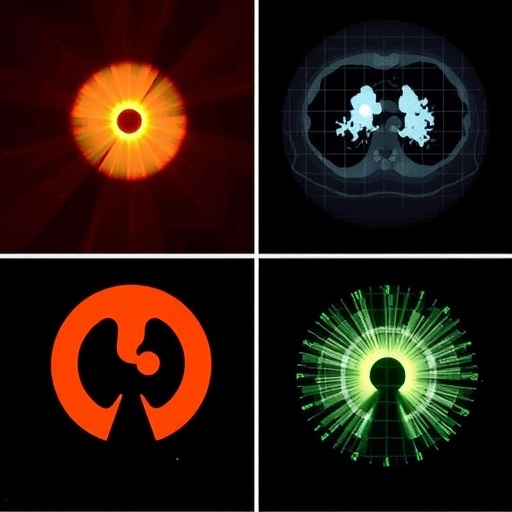In recent advancements in medical imaging technology, a groundbreaking study has emerged, shedding light on the comparative benefits of two distinct types of computed tomography (CT) in pediatric patients. Researchers, led by Arguello Fletes and his team, have conducted an exhaustive analysis aimed at investigating the radiation dose associated with cardiac CT angiography (CTA) procedures. With a focus on both photon-counting and energy-integrating detector technologies, the findings promise to reshape our understanding of safe imaging practices for children—an area of immense concern given the vulnerability of the pediatric population to radiation exposure.
The study primarily highlights the pressing need for innovation in CT technology, particularly as it pertains to pediatric imaging. Traditional energy-integrating detectors have long been the mainstay in CT scans; however, they often come with the caveat of higher radiation doses. This research challenges the status quo by introducing photon-counting detectors, which have the potential to significantly mitigate radiation exposure during cardiac CTA procedures in children. This is particularly crucial, given the increasing prevalence of cardiac conditions requiring imaging among younger patients.
The comparative analysis detailed in the study meticulously examines the radiation doses inflicted by both types of detectors. Photon-counting detectors work on a different principle than their energy-integrating counterparts. Instead of measuring the total energy of incoming photons, photon-counting detectors quantify the number of individual photons that are detected. This method can provide better image quality at reduced radiation doses, optimizing safety for the most delicate patient populations.
One major takeaway from the findings is the remarkable reduction in radiation exposure achievable with photon-counting technology. The researchers noted that when cardiac CTA scans were performed using photon-counting detectors, the radiation doses were significantly lower than those measured from energy-integrating detectors. Such findings are vital for pediatric radiology, where limiting radiation exposure is a top priority to prevent long-term health consequences in children.
Furthermore, the study emphasized the importance of aligning technical advancements with practice guidelines in pediatric care. By providing quantitative evidence that supports the reduced dose capacity of photon-counting detectors, this research encourages the adoption of newer technologies in clinical settings. It also calls for stakeholders in healthcare, including hospital administrators and radiologists, to prioritize updates that reflect this newfound knowledge, ultimately benefiting patient care.
Besides the dose reduction advantages, the researchers also delved into the quality of images obtained via both technologies. They demonstrated that while photon-counting detectors offer lower radiation exposure, they do not compromise image quality. Instead, they allow for enhanced imaging capabilities that render more precise visualizations of cardiac anatomy and pathology, thereby facilitating better diagnostic accuracy. This indicates that advanced CT technology can do more than simply lower risks; it can also enrich clinical outcomes for young patients.
Moreover, the research paints a vivid picture of the future landscape of pediatric imaging, suggesting a possible shift toward a more technology-centric approach that prioritizes safety without sacrificing efficacy. With the data in hand, pediatric radiologists can make informed decisions on the types of equipment and methodologies they choose for their practices, potentially instituting widespread reforms in pediatric CT imaging protocols.
In evaluating the broader implications of this research, a narrative of proactive healthcare emerges. The integration of less harmful imaging technology aligns perfectly with the ethos of preventive medicine, whereby the long-term health of patients is considered as vital as immediate diagnostic needs. Radiologists, armed with this knowledge, can make strides towards safeguarding children’s health against the hazards of unnecessary radiation, which is especially noteworthy in an era where patient safety and risk management are paramount.
The findings also spark interest in further research into the applications of photon-counting detectors across different medical specialties. While the current study concentrates on cardiac imaging, it raises questions about the potential for these advancements to extend to other fields within radiology, such as neuroimaging or oncological assessments. Expanding the use of safer imaging solutions could revolutionize practices across the board, echoing the ongoing evolution of technology in medicine.
As hospitals consider upgrading their imaging equipment, this study serves as a timely reminder of the responsibilities intrinsic to technological advancement in healthcare. The move towards photon-counting technology is not merely a technical upgrade but an ethical imperative that prioritizes patient welfare. It fortifies the critical message that as technology evolves, so too must the commitments of healthcare providers to protect their most vulnerable patients.
In summary, the comparative analysis conducted by Arguello Fletes and colleagues offers compelling evidence that advancements in CT technology can lead to safer imaging practices. The study underscores the dichotomy between traditional energy-integrating detectors and the innovative photon-counting variety, revealing profound differences in radiation exposure and image quality. These findings invite a reconsideration of existing imaging protocols in pediatrics and echo the call for a deeper integration of advanced technologies in daily medical practice. The future of pediatric imaging is clearly pointed towards innovations that safer imaging techniques, ensuring that children’s health remains a priority as we advance in medical science.
Subject of Research: Pediatric high-pitch cardiac CTA and radiation dose analysis.
Article Title: Comparative radiation dose analysis in pediatric high-pitch cardiac CTA using photon-counting versus energy-integrating detector CT.
Article References:
Arguello Fletes, G., Zhou, W., Malone, L. et al. Comparative radiation dose analysis in pediatric high-pitch cardiac CTA using photon-counting versus energy-integrating detector CT.
Pediatr Radiol (2025). https://doi.org/10.1007/s00247-025-06336-w
Image Credits: AI Generated
DOI: https://doi.org/10.1007/s00247-025-06336-w
Keywords: Pediatric imaging, cardiac CTA, radiation dose, photon-counting CT, energy-integrating CT, medical technology, patient safety, radiology advancements.




